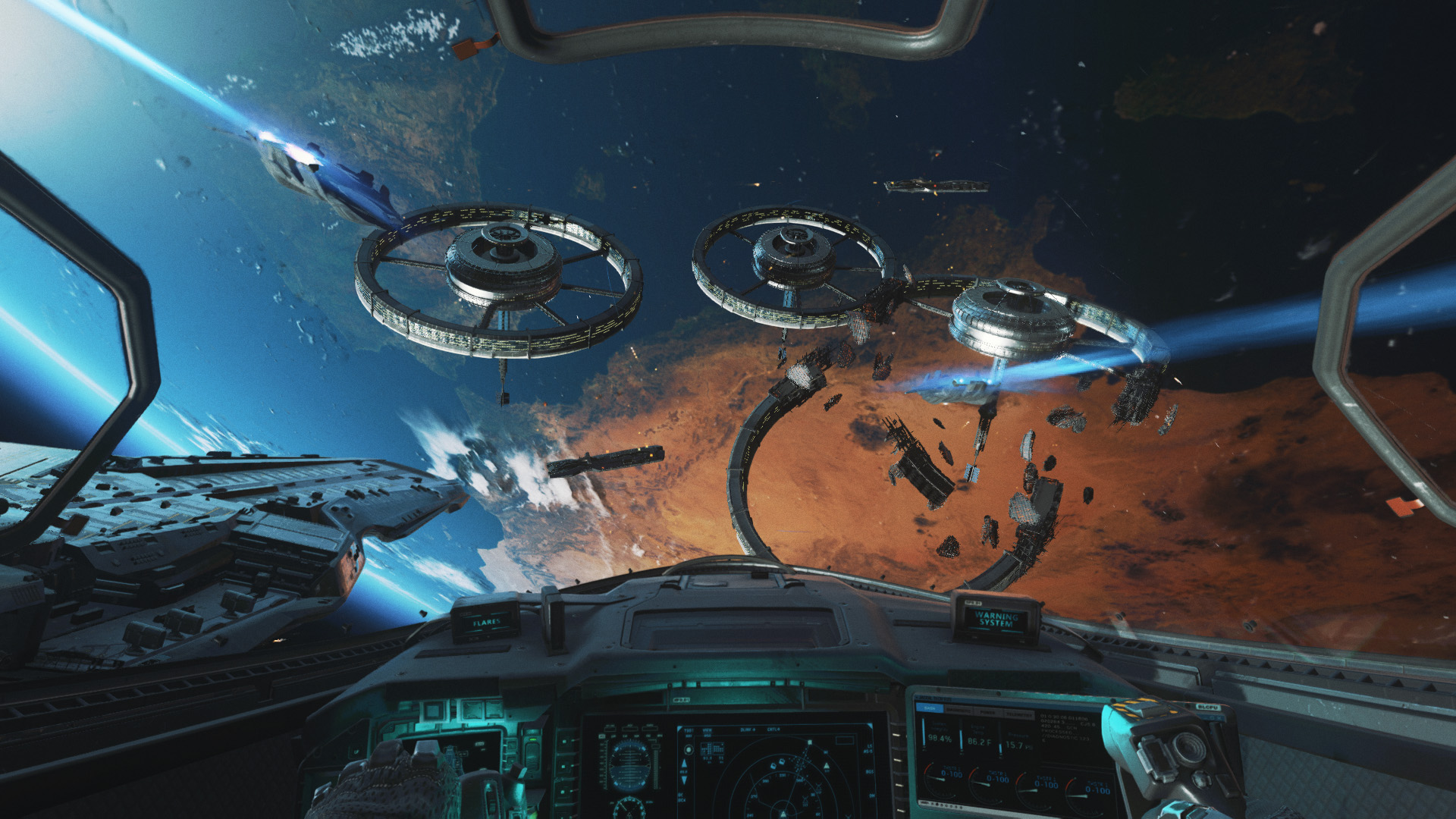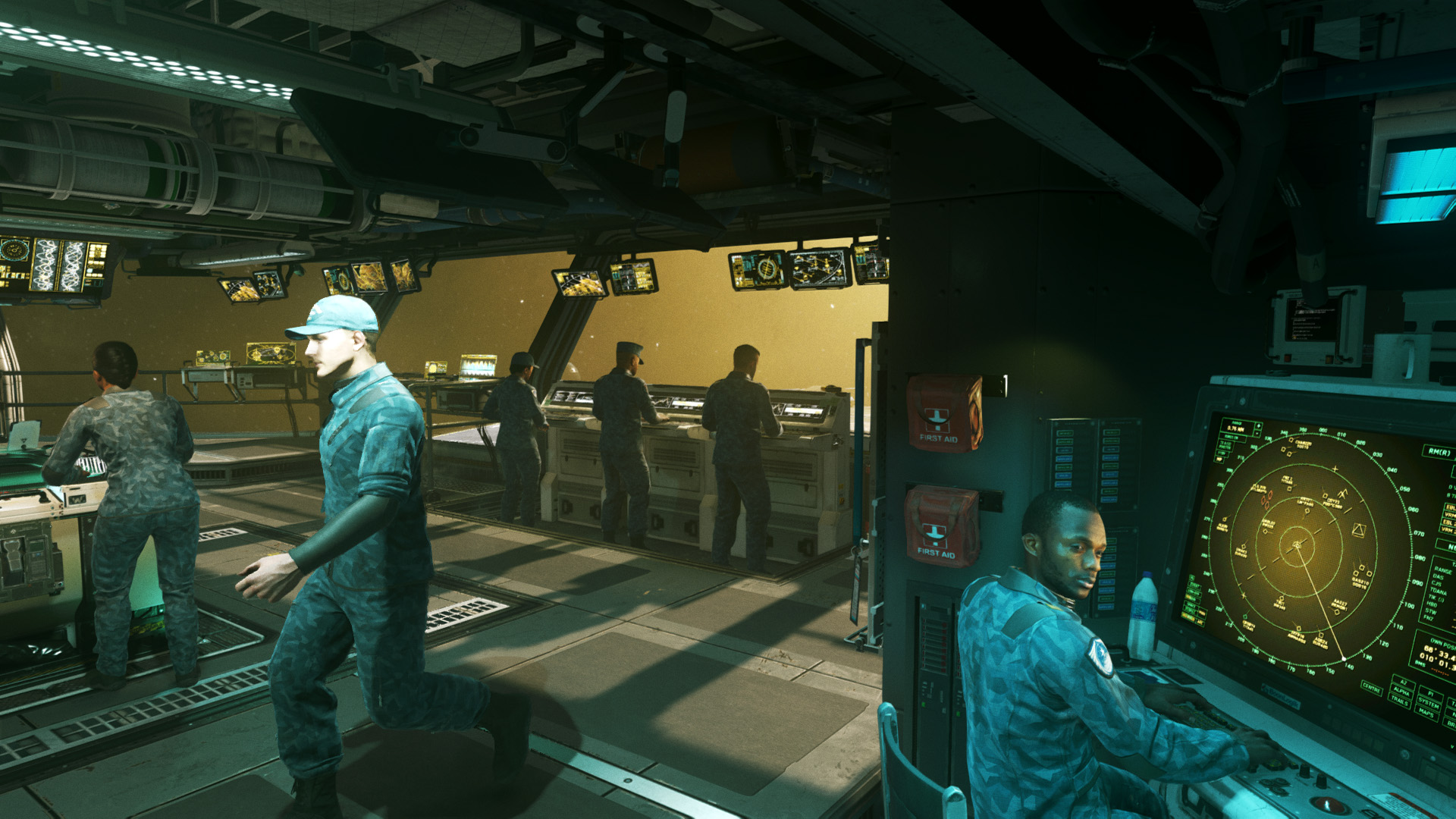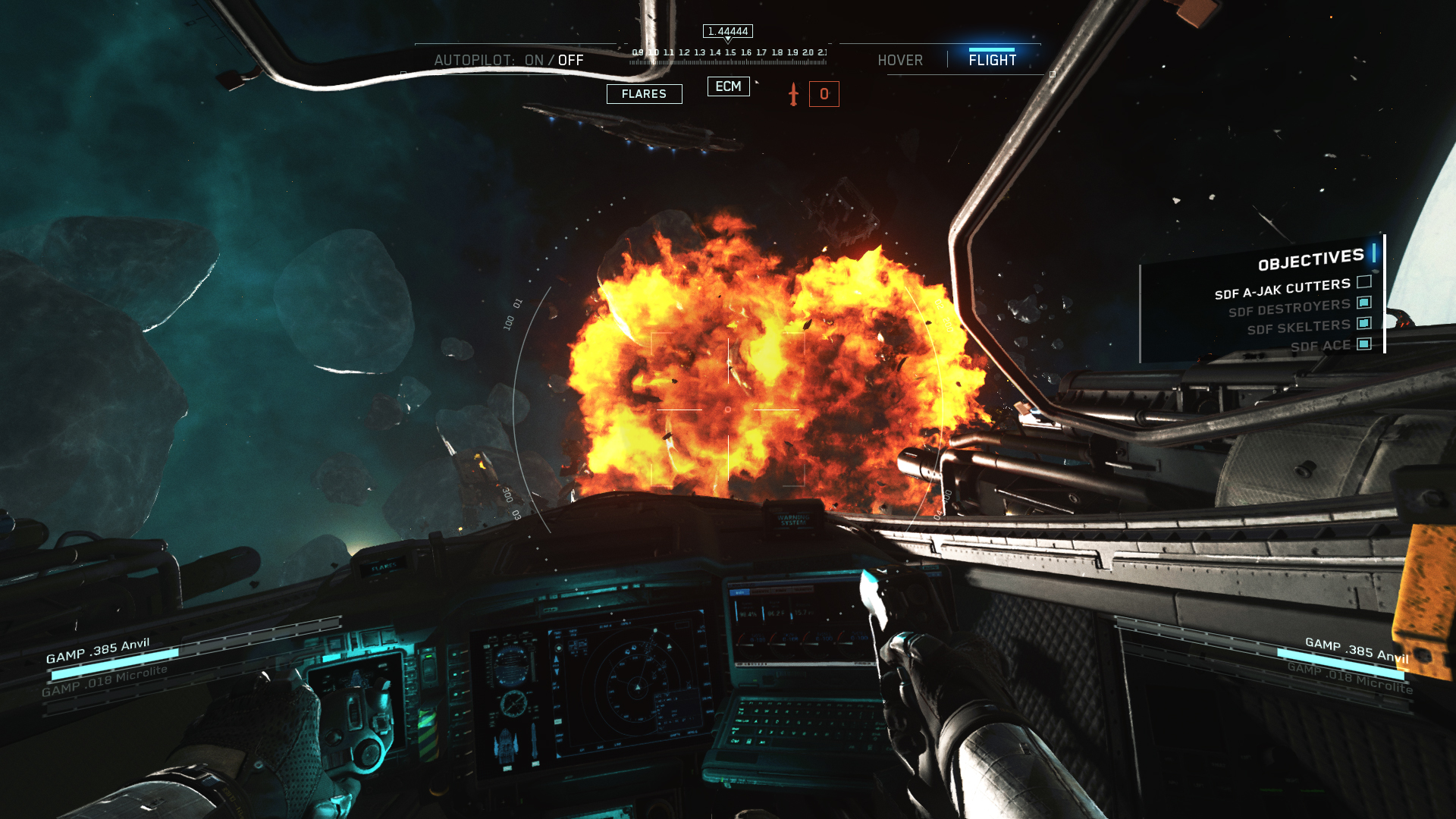The secret sci-fi greatness of Call of Duty: Infinite Warfare
What's considered one of the most disappointing COD games is full of smart world building.

When I think of the science fiction genre, the first thing that comes to my mind is the tour of the Nostromo that opens 1979's Alien. It's a surprisingly delicate sequence—the slow drift of greebled spaceship-surfaces past the camera, then the cut inside, patiently sliding through corridor after corridor of angular metal and ornate panelling. We finally settle, after ducking under a ceiling slung with machines and monitors, at the ship's bridge, and just as we are wondering when something is going to happen the ship blorps to life, rattling at us like a disturbed snake. The sequence as a whole is a kind of calling card for cinematic sci-fi, a commitment to the drama inherent in being enclosed inside a giant machine, floating in a void colder than death itself.
In comparison, the opening sequence of Call of Duty: Infinite Warfare feels distinctly inelegant. Coming to the game late, motivated in part by research for my own science fiction game, In Other Waters, I was only playing the game to wander around its central spaceship hub, The Retribution. I wasn't impressed by the opening, starting on the soft curve of the Earth with its accompanying narration on the villainous Settlement Defence Front, or by being dumped behind the visor of one of the series' near-inseparable soldiers (Wolf, this one is called) ready to drop onto the ice of Europa. There were bloody melee kills, synchronized headshots and everything else I was expecting from a Call of Duty game, but then minutes later Wolf was dead, and something new began.

Two breathless hours later, now securely set up in the Bridge of the Retribution, I understood that there was more to this game than I had expected, and, with my mind drifting to thoughts of Alien's opening sequence, I realized that against all the odds, Infinite Warfare manages to not just be a serviceable science fiction game, but a great one after all.
That was doubly surprising considering Infinite Warfare's shaky pedigree. After all, this is the bad Call of Duty, the one whose YouTube debut was disliked to oblivion, the one where that pernicious military phrase “boots on the ground” came into use and the one that sold 50 percent less than its series counterparts. After release Activision even distanced itself from its own game, with CEO Eric Hirshberg claiming “it just didn't feel enough like Call of Duty”. It's also hard not to see Infinite Warfare's 'failure' as contributing to the death of the Call of Duty campaign, with Black Ops 4 releasing without one altogether.
But perhaps “not feeling like Call of Duty” is what allows Infinite Warfare to aspire to something else. After the rote prologue, the game abandons the series' typical character switching, for example, instead keeping you firmly in the boots of one Commander Nick Reyes. This allows it to string together a continuous set of missions that seamlessly take you from a grand celebration, through an invasion, into orbit, into a chaotic space battle and then drifting into land on the Retribution. Unlike the prologue, this exhilarating charge doesn't dump lore on you, instead it elegantly lets you walk through it. Walk-and-talk is the trick here, switching out cutscenes for mobile meetings that keep forward momentum and stay economical on the details. Momentum is everything in these first missions, and there are few games that can match the sense of headlong pace the game delivers. And in these two hours Infinite Warfare comes to life in the transitions it makes between the shooting, not the shooting itself.

The true star of the show is the tech that enables this pace. Call of Duty has always had a slightly unsettling obsession with deadly military tech, but with Infinite Warfare this obsession mutates from weird gun-fetish to something that meshes beautifully with its science fiction world. Just as it was Ridley Scott's famously detail-obsessed eye that led him to start Alien with a loving wander through all of his pristinely fashioned sets, so it is Infinite Warfare's love of chunky, believable tech that leads it to lavish the players attention on the literal nuts and bolts of the game.
From the moment the game puts you in the cockpit of one of its Jackal multi-role fighters you begin to understand the drive behind it. Decked out with what sound like chunky CRT monitors, mechanical keyboards and enough toggle switches to outfit the bridge of the Nostromo, these jets are less futuristic sheen and more Top Gun in space. Like Alien's iconic industrial spaceship, the focus here is less on “realistic” and more on “real”. Holograms, AR and touch screens may be more convincing future interfaces, but nothing feels or sounds as real or as tactile as a monitor warming up, a toggle switch flicking back and forth or a vacuum seal locking in.
Keep up to date with the most important stories and the best deals, as picked by the PC Gamer team.
Once the game stations you on the deck of the Retribution this tactile, Top-Gun-in-space feel only increases. Everywhere you go on this ship (which is less of a space cruiser and more of an '80s aircraft carrier with all the external doors welded shut) you are accompanied by the groans of the hull, the hiss of pipes, the click-clack of mechanical keyboards. Every surface is covered with tech, yet these are not the nonsensical greebles of Star Wars, but heating pipes, cable rails, fluorescent tube fittings.
Many years ago I used to work on the HMS Belfast, a WW2 warship permanently docked in central London as a floating museum, and it is the engine rooms of this stout and storied warship that Infinite Warfare brought back to me, not the interior of a Millennium Falcon or USS Enterprise. These wonderfully functional spaces are filled with busy-ness too—the cacophony of the flight deck (inexplicably wet, as if it had just been whipped form the top of an ocean-going vessel) loaded with working engineers and whining forklifts, or the focussed studiousness of the bridge, with its retinue of ceaselessly typing sonar operators bathed in screenlight, a bottle of water propped up in the corner of their stations.

Yes, I was pleased to find the game's hub to be as wonderful as I had imagined, but it was the way this weighty, tech-obsessed feel bled out into the rest of the game that really got me. Every mission you take, for example, the game has you launch your Jackal from the Retribution. The launch sequence, an exquisitely detailed process focused on the drama and texture of hydraulic lifts, airlocks and shimmering interfaces filled with obscure calculations, tells you all you need to know about where developer Infinity Ward's priorities were. And yet they don't waste this space, using it for a quick back-and-forth between you and your wingwoman which sets up the mission ahead better than any briefing, showing that the game's economic approach to space doesn't just apply to the ship design.
The missions themselves also flicker with the drama of shock depressurisation, ridiculous transforming weapons, and jumping from ship to void, to interior and back out again, with all the crunching tech those transitions entail. There's a love throughout, not of scientific accuracy usually associated with “hard” sci-fi, but of engaging with the physical and technical weight of war in space. In Infinite Warfare physics is not a rulebook to be religiously followed, but a generative system, one that allows Infinity Ward to imagine what solutions and systems of offence and defence combat in a vacuum might entail and have fun making them as weighty and satisfying as possible.
It's all about texture, the texture you can feel—that's why everyone in the Retribution's bridge is endless clacking away at their keyboards, or your Jackal has a bespoke animation for the little ladder that hinges out of its ornately plated hull panels. That's what Alien's opening is about too, surrounding you with texture, with detail, with a sense of the danger of the void. Infinite Warfare wants you to feel that texture, to engage with it. It basically forces you to by making you launch your lovingly crafted space-jet every mission. That's where its sci-fi greatness stems from: this understanding that it's not the lore dumps and text scrolls of intergalactic wars or whimsical planet-hopping that makes space such a compelling setting, but the sheer weight, the complexity, the technicality of life and death among the stars.


